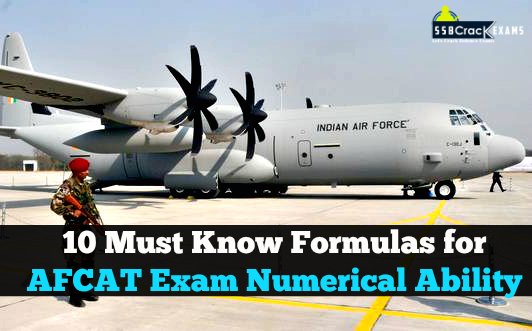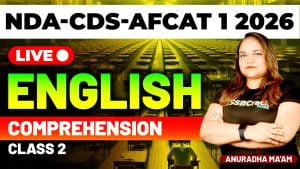If you are writing afcat exam in near future, there are few simple AFCAT exam numerical ability maths formulas you want to keep on your finger tips to solves the mathematics question of AFCAT question paper. Afcat exam paper consist of very basic mathematics questions and these formulas will help you to clear them easily. As the minimum practice is required to solve afcat exam maths problems, for which one might join our afcat exam coaching online for better practice and analytic reports.
10 Must-Know Formulas for AFCAT Exam
Decimal Fraction:
- A decimal fraction is a fraction in which denominator is an integer power of ten. (The term decimals are commonly used to refer decimal fractions). Generally, a decimal fraction is expressed using decimal notation and its denominator is not mentioned explicitly
Examples: 1/10 = .1 , 1/100 = .01
- Conversion of a Decimal into Common Fraction: Put 1 in the denominator under the decimal point and annex with it as many zeros as is the number of digits after the decimal point. Now, remove the decimal point and reduce the fraction to its lowest terms.
Examples: 0.5 = 5/10=1/2
- Some Basic Formulas:
- (a + b)(a – b) = (a2 – b2)
- (a + b)2 = (a2 + b2 + 2ab)
- (a – b)2 = (a2 + b2 – 2ab)
- (a + b + c)2 = a2 + b2 + c2 + 2(ab + bc + ca)
- (a3 + b3) = (a + b)(a2 – ab + b2)
- (a3 – b3) = (a – b)(a2 + ab + b2)
- (a3 + b3 + c3 – 3abc) = (a + b + c)(a2 + b2 + c2 – ab – bc – ac)
- When a + b + c = 0, then a3 + b3 + c3 = 3abc.
Simplification:
- Rule of ‘BODMAS’: This BODMAS rule depicts the correct sequence in which the operations are to be executed, so as to find out the value of given expression. Full form of BODMAS is B – Bracket, O – of, D – Division, M – Multiplication, A – Addition and S – Subtraction. Thus, while solving or simplifying a problem, first remove all brackets, strictly in the order (), {} and ||. After removing the brackets, we will use the following operations strictly in the following order: (i) of (ii) Division (iii) Multiplication (iv) Addition (v) Subtraction.
Average:
- Average = (Sum of observations/Number of observations)
- Suppose a train covers a certain distance at x kmph and an equal distance at y kmph. Then, the average speed of train during the whole journey is kmph (2xy/x+y)kmph.
Percentage:
- By a certain percent, we mean that many hundredths. Thus, x percent means x hundredths, written as x%. To express x% as a fraction: We have, x% = x/100
- To express a/b as a percent: We have, a/b = (a/b x 100)%
- Percentage Increase/Decrease: If the price of a commodity increases by R%, then the reduction in consumption so as not to increase the expenditure is: [(R/(100+R)) x 100]%. If the price of a commodity decreases by R%, then the increase in consumption so as not to decrease the expenditure is: [(R/(100-R)) x 100]%.
- Result on Population: Let the population of a town be P now and suppose it increases at the rate of R% per annum, then: population after n years = P (1+(R/100))n Population n years ago= P/ (1+(R/100))n
- Result on Depreciation: Let the present value of a machine be P. Suppose it depreciates at the rate of R% per annum. Then: Value of the machine after n years = P (1-(R/100)n , Value of the machine n years ago = P/ (1-(R/100)n, If A is R% more than B, then B is less than A by [(R/(100+R)) x 100] %, If A is R% less than B, then B is more than A by [(R/(100-R)) x 100] %
Ratio:
- The ratio of two quantities a and b in the same units, is the fraction and we write it as a : b. In the ratio a : b, we call a as the first term or antecedent and b, the second term or consequent. Eg. The ratio 5 : 9 represents 5/9 with antecedent = 5, consequent = 9.
- Rule: The multiplication or division of each term of a ratio by the same non-zero number does not affect the ratio. Eg. 4 : 5 = 8 : 10 = 12 : 15. Also, 4 : 6 = 2 : 3.
Proportion:
- The equality of two ratios is called proportion. If a : b = c : d, we write a : b :: c : d and we say that a, b, c, d are in proportion. Here a and d are called extremes, while b and c are called mean terms. Product of means = Product of extremes. Thus, a : b :: c : d (b x c) = (a x d).
Simple Interest:
- Principal: The money borrowed or lent out for a certain period is called the principal or the sum.
- Interest: Extra money paid for using other’s money is called interest.
- Simple Interest (S.I.): If the interest on a sum borrowed for certain period is reckoned uniformly, then it is called simple interest. Let Principal = P, Rate = R% per annum (p.a.) and Time = T years. Then Simple Interest = (P x R x T)/100
Profit and Loss:
- Cost Price: The price, at which an article is purchased, is called its cost price, abbreviated as C.P.
- Selling Price: The price, at which an article is sold, is called its selling prices, abbreviated as S.P.
- Profit or Gain: If S.P. is greater than C.P., the seller is said to have a profit or gain.
- Loss: If S.P. is less than C.P., the seller is said to have incurred a loss.
- Gain = (S.P.) – (C.P.)
- Loss = (C.P.) – (S.P.)
- Loss or gain is always reckoned on C.P.
- Gain Percentage: (Gain %) = (Gain x 100) / C.P.
- Loss Percentage: (Loss %) = (Loss x 100) / C.P.
- Selling Price: (S.P.) = [ ((100 + Gain %)/100) x C.P.]
- Selling Price: (S.P.) = [ ((100 – Loss %)/100) x C.P.]
- Cost Price: (C.P.)= [ (100/(100 + Gain %)) x S.P.]
- Cost Price: (C.P.)= [ (100/(100 – Loss %)) x S.P.]
- If an article is sold at a gain of say 10%, then S.P. = 110% of C.P.
- If an article is sold at a loss of say, 20% then S.P. = 80% of C.P.
- When a person sells two similar items, one at a gain of say x%, and the other at a loss of x%, then the seller always incurs a loss given by: Loss % = (x/10)2
- If a trader professes to sell his goods at cost price, but uses false weights, then Gain % = [(Error/(True Wight – Error)) x 100 ]%
Hope these formulas would help you to solve the afcat exam numerical ability problems. If you think we have missed any formula, do write it in the comment section below. You can also join our AFCAT exam online coaching to crack AFCAT exam 2020.




















